Compiled by Geoff Goodall


The company model was Short S.16, designed by their chief designer Arthur Gouge. Construction was a steel fuselage frame and single-spar fabric-covered metal wing, and to keep operating costs to a minimum, power was two 85 hp Pobjoy Niagara radials with geared large radius wooden propellers.
The protoype first flew in August 1933 and Short Brothers Ltd commenced production at Rochester, Kent. Three were completed at the Short Brothers Seaplane Works and launched from there, while the main production was at Rochester Aerodrome. From 1935 the Mk.2 model had slightly more powerful Niagara engines in raised nacelles, provision for a sixth passenger seat and refined windows for the cockpit and cabin, and marginally imporved performance:
Scion Mk.1: 85hp Pobjoy Niagara 1 or II
Scion Mk.2: 90hp Pobjoy Niagara III
Production at Rochester was later taken over by Pobjoy Airmotors and Aircraft Ltd, completing the last six Scions.
A total of 22 Short Scions were built. They flew extensively on short routes throughout the United Kingdom as well as joyriding for the popular travelling airshows C.W.A.Scott's Air Displays and Campbell Black's Air Display. At the outbreak of WWII surviving British Scions were impressed for the RAF as light transports.
Robert Bryce & Co Pty Ltd, Melbourne was the Australian agency for Short Brothers and also Pobjoy Airmotors, handling the purchase of three new Scions for Adelaide Airways as well as General Aircraft Monospars for Australian airlines. In addition Robert Bryce supplied replacement Pobjoy engines and airframe parts for the Scions and Monospars.
A larger development of the Scion, the Short S.22 Scion Senior was a 9 passenger floatplane powered by four Pobjoy Niagaras. Five were built, plus a landplane version, at Rochester 1935-36. In April 1938 a newly-formed Australian company named Safety Airways (Newcastle) Ltd announced that it would fly scheduled services from Sydney harbour to Newcastle harbour using Scion Senior floatplanes configured for 10 passengers, with stops at coastal towns enroute. Press reports later in the year indicated other aircraft types were being considered and that local councils were refusing their applications to set up a flying boat base. Nothing further came of the proposal until 1945 when the principles of Newcastle Safety Airways acquired a RAAF disposals Douglas Dolphin amphibian A35-3 and attempted to register it as a civil aircraft, but the Deparment of Civil Aviation refused a CofA due poor single-engine performance.
Adelaide Airways Ltd
Adelaide Airways Ltd was founded in July 1935 by the Adelaide Steamship
Co, placing orders for a new Scion VH-UUT and a Monospar ST.25
VH-UUV, both to be shipped from England. The new airline commenced
operations on 29 October 1935, the Scion flying twice
weekly Adelaide-Mount Gambier-Melbourne return, while the Monospar
covered shorter services to SA towns. A second Scion VH-UVQ was
ordered several months later. On 26 November 1935 the
Adelaide-Broken Hill route was commenced, connecting at Broken Hill
with Western and Southern Provincial Airlines (WASP) to Sydney.When the original Scion was wrecked in January 1936 in a forced landing caused by the failure of one of its Pobjoy engines, a settlement was reached with Pobjoy Airmotors to supply a replacement Scion VH-UTV. Two new DH.89 Rapides VH-UVI and VH-UVT entered service in April 1936 to increase frequency of services.
In early 1936 Ivan Holyman, of Holymans Airways had talks with the principles of Adelaide Airways with a view to a merger. Both airlines were already backed by shipping companies and in a major business undertaking for the day, other shipping lines became involved. With the extra finance, Adelaide Airways purchased West Australian Airways Ltd effective 1 July 1936, taking over the WAA Adelaide-Perth route, using WAA's aircraft and crews.
By August 1936 Adelaide Airways linked Adelaide with Broken Hill, Cowell, Kangaroo Island, Mildura, Millicent, Mount Gambier, Naracoorte, Port Lincoln, Renmark, plus Hamilton, Melbourne and the ex-WAA Adelaide-Ceduna-Forrest-Kalgoorlie-Perth service. However this was just a step in the merger plan: on 13 May 1936 a new company Australian National Airways Pty Ltd was founded incorporating all the assets and routes of Adelaide Airways and Hoymans Airways Ltd, with capital provided by five shipping companies.
ANA commenced operations 2 November 1936 as Australia's largest airline and reinforced that fact in October 1938 when it purchased a controlling interest in Airlines of Australia Ltd, its only rival with Douglas aircraft. Airlines of Australia continued to operate under its own name until absorbed into ANA effective 1 July 1942. Postwar ANA continued in competion with the Goverment-founded Trans Australia Airlines, until 1957 when ANA was taken over by the much smaller Ansett Airways and reformed as Ansett-ANA, later renamed Ansett Airlines of Australia.
| 34 | Built at Rochester Seaplane Works by Short Bros (Rochester and Bedford) Ltd. Third production Scion 1, completed as a twin float seaplane |
| 5.10.34 | First launched Rochester. Test flown on River Medway by J. Lankester Parker |
| 1.2.35 | British CofA issued Papuan Concessions Ltd, London. |
| 24.4.35 | Registered G-ACUX: Papuan Concessions Ltd, London. To be based Port Moresby, New Guinea |
| Papuan
Concessions Ltd was an associate company of Oroville Dredging Co Ltd,
London which was exploring Oroville and other areas of New Guinea for
gold. | |
| 3.35 |
Intended to be flown to Australia by company pilot Flight Lieutenant Stuart A. Campbell, who had considerable experience on flying boats. However instead it was sent by sea. |
| 4.35 | Shipped to Australia as boxed cargo on Port Alma |
| 27.5.35 | Arrived at Sydney. Wooden crate containing the floats was dropped 6 feet on to the wharf |
| Moved
by lighter from wharf to Cockatoo Island in Sydney harbour for assembly
at Cockatoo Island Aviation Division. The two Pobjoy engines had
to be sent to Melbourne for mandatory modifications required by the
Civil Aviation Branch following failures of the same engine model
had caused forced landings by GAL Monospars. | |
| Lengthy
delays waiting for the engines to be returned and other problems.
Engineer for the Scion, George
Howden proceeded to Port Moresby by ship, with a supply of spare parts | |
| Delivery flight from Sydney to New Guinea further delayed when the installed radio equipment was found to be defectived. | |
| 12.7.35 | G-ACUX departed Sydney, pilot Campbell with mechanic W. Hellon. Reached Daru on the south coast of New Guinea 21.7.35. |
| Campbell
found that, as he had expected, the floatplane Scion was underpowered,
having a slow cruising speed and difficult to get airborne off the
water. He later wrote "The Scion may
have been alright for its original purpose but it was cruel to ask a
man to take it into the wilds of New Guinea." | |
| 23.7.35 | Campbell
and Howden departed Daru to fly to the
Oroville base camp at Kiunga. Starboard engine crankcase failure
resulted in an emergency landing on the fast-flowing Fly River. They
drifted 60 miles downstream and after several days tied up at the jetty
of the nearest planation Madiri. They had traded tins of tobacco for
food from natives along the way. A searching RAAF Southampton flying boat A11-1 located them at Madiri and landed on the river. |
| Scion was towed along the Fly River to its mouth near Daru by the launch Vailala skippered
by New Guinea explorer Ivan Champion. Scion was pulled up on a beach
and tied up to coconut trees at Daru while waiting for a replacement
engine to arrive by coastal steamer, which left Sydney 3.8.35. After installation, both engines developed oil leaks during test flying at Daru | |
| 1.9.35 | Campbell and engineer Howden departed Daru for the Oroville Expedition base camp at Kiunga |
| 9.35 | At Kiunga the floats were removed and conventional wheeled undercarriage installed. |
|
Numerous exploratory flights were conducted in New Guinea and West
Papua searching for areas with good prospects of gold. Campbell had
continuous trouble with engine oil leaks. | |
| 2.10.35 | Registered VH-UUP: Papuan Concessions Ltd, Melbourne Vic c/- Brown & Dureau Ltd, Melbourne (agents) |
| 6.11.35 | Campbell
diverted to Daru due weather on a flight to Kiunga. Radio
communications at Daru were cut and his safe arrival could not be
reported. An aerial search had been commenced before weather allowed
Campbell to get airborne at Daru on 9.11.35 |
| 12.35 | The
Oroville expediton had returned to Port Moresby.
The costly search for gold had been disappointing and the Oroville
company was disenchanted by the poor performance of the Scion.
Expedition leader American Ward Williams returned to USA to raise funds
for a new expedition with more suitable aircraft. Williams
returned with Sikorsky S-39B NC54V in August 1936, which was flown by
Campbell in New Guinea |
| Despite the Australian
certification paperwork, the Scion was flying in New Guinea as G-ACUX
at the end of November 1935 at least. Postal communications between
Australia and New Guinea were limited to monthly coastal steamers at
that time. | |
| .36 | VH-UUP ferried from Port Moresby to Sydney for disposal, flown by Stuart Campbell. Because one engine was burning oil at an alarming rate, he carried many cans of oil in the cabin and was required to land every 100 miles or so to top up the engine oil tank. |
| 10.36 | Floats removed and fitted with landplane undercarriage during overhaul by DeHavilland Aircraft Pty Ltd at Mascot Aerodrome, Sydney. Stored in their hangar pending resale. |
| 2.10.37 | Change of ownership: Sidney D. Marshall t/a Marshall Airways, Mascot Aerodrome, Sydney |
| Used for joyriding and charter work,
especially medical flights taking medical specialists from Sydney to NSW towns
or bringing patients to Sydney on charter to NSW road ambulance
service. | |
| 9.12.38 | Local
flight from Mascot, pilot S.D. Marshall carrying professional
photographer John T. Harrison to take photographs in the Sydney area. |
| 3.40 |
DCA aircraft inspection report notes that VH-UUP has NSW ambulance service maltese crosses painted on both sides of the fuselage, in connection with its use as an air ambulance. |
| 8.5.48 | Undercarriage received
minor damage due to a flat tyre while taxying after landing at Bega NSW
on an ambulance flight, pilot S.D.Marshall. Marshall carried out
repairs and fitted a replacement tyre the next day and aircraft departed. |
| 23.12.47 | CofA expired, retired at Mascot in Marshall Airways hangar |
| c51 | Ferried from Mascot to Marshall Airways' new base Bankstown Airport, Sydney |
| 6.8.51 | Struck-off Register in the 1951 DCA census of unairworthy aircraft |
| 30.10.53 | Restored to Register: S.D. Marshall, t/a Marshall Airways, Bankstown Airport Sydney |
| Trevor Thiele flew Marshall Airways' VH-UUP at Bankstown between 10.53 and 1955, mostly on joyrides. He was
checked out on the Scion by veteran Sydney pilot Joe Palmer. Thiele
recalls "I simply stood behind him and watched what he did. It had simple instruments and was a beautiful thing to fly. The nice little round Pobjoys were 7 cyclinder radials which were very reliable and just used to tick away like a pair of wrist watches. They were geared engines, and you would cruise, from memory at about 2800 rpm while getting 3200 to 3500 rpm on takeoff. But spare parts were a problem. We did have problems with the engines, but only in terms of the reliability of the spark plugs, when you would sometimes have to taxy back after a magneto-check and get a plug changed." The Scion had a marvellous fuel range, fuel for something like six or seven hours' flying, but unfortunately the engines used so much oil that the oil range was only about two hours. So we went off with plenty of petrol but we used to carry a drum of oil so we could stop somewhere and top up the oil tanks. It was an incredible load-carrier, taking five people plus the pilot, and a considerable quantity of fuel, on only 180 horsepower. It wasn't a fast cruiser, because it had the high wing with a very deep section which it modelled for the later Short Empire flying boats. About 85 mph (137 km/h) was pretty good cruising. The pneumatic brakes operated from a little pressure vessel in the rear of the fuselage which was pumped up from outside. The air pressure would leak after a while, so you would arrive at some place with a nice smooth runway and find you had only a small amount of air pressure left for the brakes." | |
| 10.8.55 | Struck-off Register. Retired in Marshall Airways hangar at Bankstown. Marshall Airways replaced the Scion with Avro Ansons. |
| 55-73 | VH-UUP was parked in Marshall Airways hangar at Bankstown. By 1970 it was suspended from the roof beams with tailplane removed. |
| .73 | Hudson VH-AGJ, DH.80 Puss Moth and Scion VH-UUP were purchased by vintage aircraft exporting company Hendon Aeroplane Co, Sydney c/- Maurice Whittington |
| 10.73 | Resold to Sir William Roberts t/a Strathallan Collection, Strathallan Castle, Auchterarder, Perthshire, Scotland |
| 11.73 | Shipped from Sydney to Great Britain |
| 21.3.77 | Moved into Strathallan museum. Not reassembled, only the fuselage was displayed |
| 25.3.77 | Restored to British Register G-ACUX: Strathallan Collection, Auchterader, Scotland |
| 14.7.81 | The aircraft of the closed Strathallan Collection were sold by auction by Christies of London. |
| 14.7.81 | Purchased at auction by Ulster Folk and Transport Museum, Belfast, Northern Ireland |
| 7.12.81 | Struck-off British Register |
| Held by the Ulster Folk and Transport Museum for eventual restoration for display. A 2012 reports says the airframe has deteriorated badly while in storage. | |
| 11.19 |
The museum moved
VH-UUP from storage to a new temporary storage site, pending
restoration for display in a new building. The wings were intact but
the fuselage was stripped down to bare metal tubing frame. |
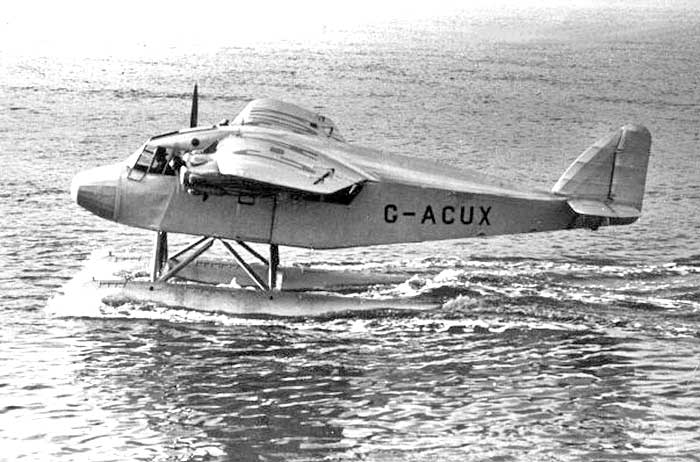
the Medway by J. Lankester Parker before it was shipped to Australia Photo: Ed Coates Collection
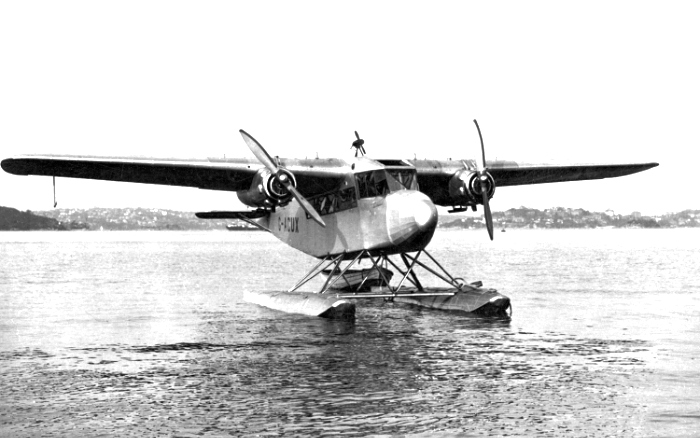
G-ACUX
on Sydney Harbour near Kirribilli in 1935 before departing for New
Guinea. National Library of Australia

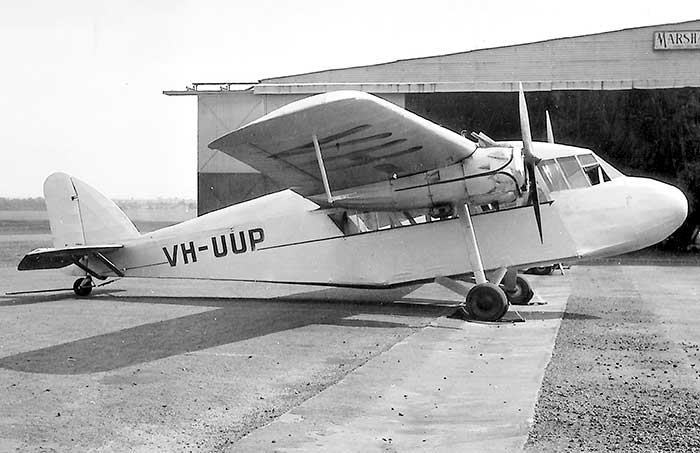
Photo: Barrie Colledge

John Hopton caught her parked close to the open doors in April 1962. Photo by John Hopton
| 8.35 | Built at Rochester Aerodrome by Short Bros (Rochester and Bedford) Ltd. |
| Ordered as a new aircraft by Adelaide Airways | |
| Registration reservation G-ADDS: Adelaide Airways Ltd, Adelaide SA | |
| 23.8.35 | First flight Rochester, painted as VH-UUT. Pilot John Parker |
| 26.8.35 | CofA issued |
| Shipped to Australia as cargo on SS Barrabool | |
| 4.10.35 | Arrived Port Adelaide, taken by road to Parafield Aerodrome for assembly |
| 19.10.35 | First test flight Parafield after assembly |
| 24.10.35 | Registered VH-UUT: Adelaide Teamship Company Ltd, trading as Adelaide Airways Ltd, Parafield Aerodrome, Adelaide SA |
| 24.10.35 | Australian CofA issued |
| 29.10.35 | VH-UUT
flew Adelaide Airways' first service, Adelaide-Mount Gambier-Melbourne,
Captain H. G. Kirkman. Returned the following dasy. The company commenced operations with this Scion and a General Aircraft Monospar VH-UUV. |
| 22.1.36 | Crashed near Meadows SA. Badly damaged when overturned during a forced landing. The starboard engine seized when only 20 miles from Parafield on a scheduled Melbourne-Adelaide flight. The aircraft struck a ditch during the landing roll and overturned. Captain H.G.Kirkman and 4 passengers received minor injuries. |
| Wreck stored in hangar at Parafield | |
| 20.2.36 | Letter from Adelaide
Airways to DCA: VH-UUT will be shipped to London for repairs by the
makers and a new Scion will be sent as a substitution. The company has
ordered two new DH.89 Rapides which will be shipped from London today
by P&O liner. DCA replied 28.2.36 allocating registration VH-UTV to the replacement Scion. |
| 26.2.36 | Struck-off Australian Register |
| Wreck purchased by Pobjoy Airmotors and Aircraft Ltd, Rochester Aerodrome, Kent The engine manufacturer had taken over the Short Brothers Scion production works at Rochester Aerodrome where it constructed the last of the Scions. | |
| .36 | Damaged airframe of VH-UUT was shipped to England. Rebuilt at Rochester. |
| 13.7.36 | Letter from Robert Bryce & Co to DCA: "VH-UUT
was recently returned to our principles, Messrs Pobjoy Airmotors and
Aircraft Ltd. It will be registered in Britain for its repair." |
| 1.11.37 | Registered G-AEOY Arabian Airways Ltd, London: to be based Khormaksar, Aden |
| 17.12.37 | crashed |
| 4.38 | Struck-off British Register |

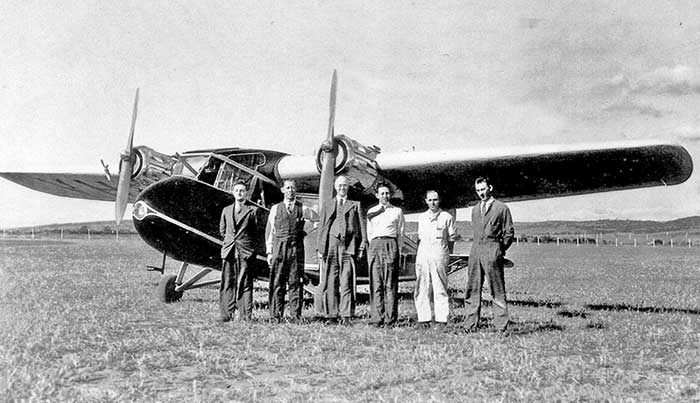
Senior Engineer Sam Woohouse is on the far right. Photo courtesy Brian Woodhouse

at Parafield in 1936 before shipped back to England for rebuilding. Photo: Brian Woodhouse
| .35 | Built at Rochester Aerodrome by Short Bros (Rochester and Bedford) Ltd. |
| 35 | Ordered new by Adelaide Airways, South Australia |
| 23.11.35 | British CofA issued as VH-UVQ: Adelaide Airways Ltd, Adelaide, South Australia |
| Shipped to Australia. | |
| Assembled at Parafield SA | |
| 21.1.36 | Registered VH-UVQ: Adelaide Airways Ltd, Parafield Aerodrome, Adelaide, South Australia |
| 21.1.36 | Australian CofA issued |
| 1.11.36 | Change of ownership due merger: Australian National Airways Pty Ltd, Melbourne Vic All aircraft of the associated companies were transferred to ANA on this date VH-UVQ was not given an ANA fleet name. |
| 6.5.37 | Traded-in on a new DH.89 Rapide to: De Havilland Aircraft Pty Ltd, Mascot Aerodrome, Sydney NSW |
| 7.5.37 | Change of ownership: Nicholas D. Healy, Sydney NSW. Operated as General Air Transport. |
| 23.6.37 | Sydney Morning Herald newspaper report: "General
Air Transport, a syndicate formed by Mr. N.D.Healy, has acquired a
Short Scion aircraft VH-UVQ to commence the transport of fresh fish
from the south coast to the country districts of NSW. Mr.
N.B.Littlejohn has been appointed chief pilot and he will make his
headquarters Nowra, where a new hangar has been built by the Nowra
Council. A ground engineer and other staff will be appointed." The story continued with Mr. Healy's optimistic plans to carry half ton consignments of fresh fish from Nowra to Bathurst, Goulburn, Dubbo and numerous other NSW towns. Locally produced fruit, vegetables and poultry would be carried as back-loading. The fish would be carried unchilled in hermetically-sealed waxed cartons. |
| 20.7.37 | First service departed Nowra |
| 10.37 | Indications are that VH-UVQ was leased back to ANA at Essendon for periods: - 7.10.37 night flying Essendoin to inspect night landing system, pilot F. Francis - 10.11.37 local flight Essendon by pilot C.A.Mulholland, for photographer John T. Harrison to take pictures of the newly assembled DC-2 VH-UZJ Kyilla on a test flight by Douglas pilot V.E.Bertrandias. |
| 12.37 | Engine overhaul at Nowra NSW. Based there. |
| 20.1.38 | DCA inspection report at Nowra after CofA renewal overhaul: owner stated as General Air Transport: excellent condition |
| 12.2.38 | Local flight Essendon, pilot L.W. Lohse, carrying professional photographer John T. Harrison |
| 38 | Based at Nowra NSW, maintained by Airflite Pty Ltd at Mascot. Now being flown by Joe R. Palmer for charter, joyriding etc. |
| 9.38 | N.D.Healy sold the Scion to finance the purchase of Waco YQC-6 VH-UVW from Southern Airlines and Freighters Ltd, Melbourne |
| 22.9.38 | Change of ownership: Aerial Transport and Training Ltd, Brisbane Qld |
| 9.38 | VH-UVQ undergoing overhaul at Mascot by Airflite Pty Ltd for its new owner. |
| 10.38 | Airflite
founder engineer A.H.P.Lewis advised DCA that he had given two Short
Scion floats ex VH-UUP an overhaul and repaired a dent in the nose of
one float. He had signed out the floats as airworthy and was fitting
them to VH-UVQ during its overhaul. |
| 14.10.38 | Moved
from Airflite hangar to Cooks River on boundary of Mascot Aerodrome on
a wheel chassis. Floats fitted on the banks of the river and test flown as a floatplane. Then departed on delivery flight to Brisbane. |
| Based Brisbane operating as a floatplane on the Brisbane River. AT&T planned to operate passenger services between Bruisbane and Southport (later developed as Surfers Paradise) | |
| 1.39 | Tailplane and elevators damaged by water impact |
| 20.1.39 | CofA expired. AT&T advised DCA it would not be renewed immediately because of the cost of the tailplane damage and also engine troubles |
| 29.6.39 | DCA memo: VH-UVQ inspected at Brisbane by a DCA inspector. Airframe is now in good condition |
| 17.7.39 | DCA memo: inspected again at Brisbane. The Pobjoy engines have serious faults. Extensive correspondence with DCA regarding approval for methods of engine repairs. |
| 12.39 | Stored in a shed on the Brisbane River in the Brisbane suburb of Bulimba. It is offered "as is" for sale by the liquidators of Aerial Transport and Training Ltd |
| 3.4.40 | Letter
to DCA from Mr. N.C. Marconi, who had been a Director and shareholder
of Aerial Trasport and Training Ltd now in receivership. He advised
that parts had been stolen from the aircraft while in storage, incuding
its compass. |
| 5.41 | VH-UVQ is stored at a slipway adjoining Marconi's home on Brisbane River |
| 5.2.46 | Struck-off Register |
| 3.49 | Advertisement in Australian "Aircraft" magazine: "For Sale: apply N.C.Marconi, Oxford Street, Bulimba Qld: Two Short Scion mainplanes,one pair Scion floats, two Pobjoy Niagara 5 engines" |
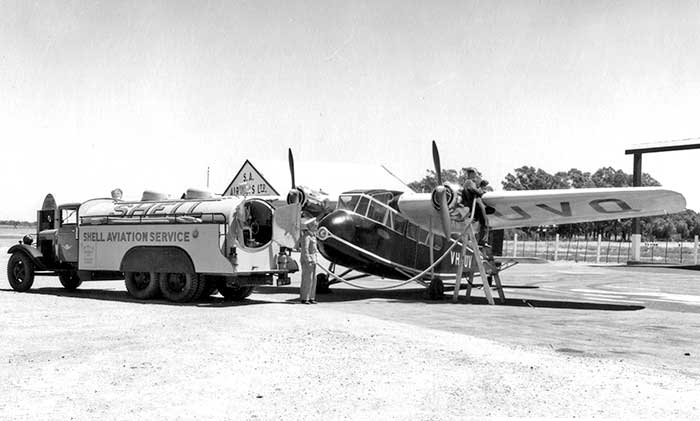
Photo: Civil Aviation Historical Society of SA, via SA Aviation Museum
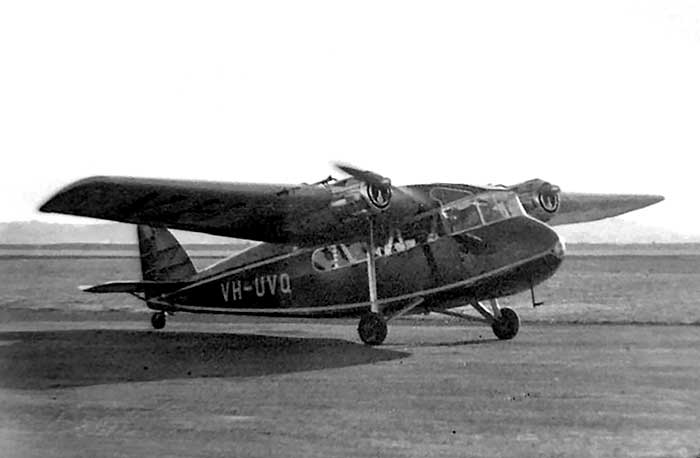
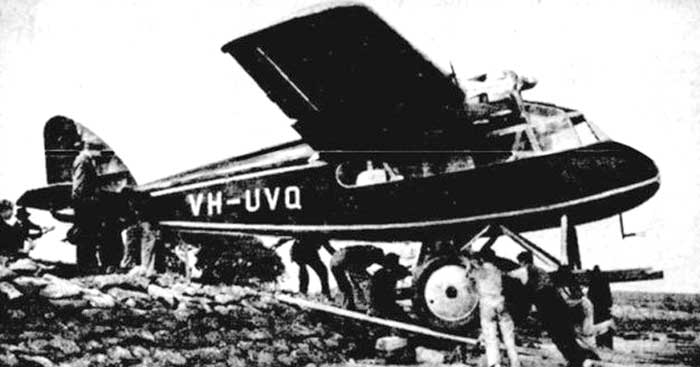
Courtesy Graeme Parsons collection
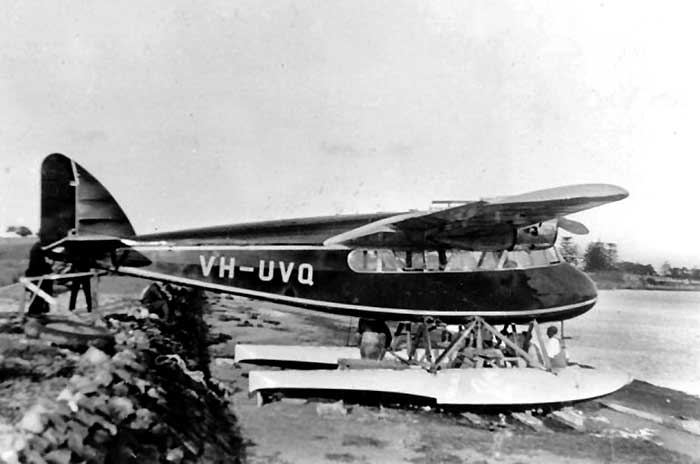
| .36 | Built at Rochester Aerodrome, Kent by Short Brothers (Rochester &
Bedford) Ltd. Production Short S.16 Scion Mk.II fitted with two 90hp Pobjoy Niagara radial engines. |
| Allocated to Adelaide Airways Ltd
as part of a settlement with Pobjoy Airmotors following Scion VH-UUT
being wrecked in a forced landing due Pobjoy Niagara engine failure.
VH-UUT's wreck was shipped from Adelaide to Pobjoy at Rochester
Aerodrome where it was rebuilt for re-sale. | |
| 9.3.36 | First flight Rochester |
| 11.3.36 | British CofA issued to S.793 in name of Robert Bryce & Co Pty Ltd, Melbourne, Australia (Australian agents for Short Bros) |
| Note:
some sources state that this Scion was allocated British registration
G-ADDW (based on Scion production being allocated the range G-ADDN to
G-ADDX) but was not used because of its immediate sale to Australia. An amateur-built French Pou-du-Ciel Flying Flea was registered G-ADDW on 19 March 1936. | |
| Shipped to Adelaide, assembled at Parafield | |
| 5.36 | Assembled at Parafield by Adelaide Airways |
| 25.5.36 | Testflown Parafield after assembly |
| 28.5.36 | Added to Civil Register VH-UTV: Adelaide Airways Ltd, Adelaide SA |
| Although
the strict sequential Australian registration allocations had reached
the VH-UV series by this date, DCA allocated a number of unused earlier
registrations. | |
| 36 | Flew scheduled passenger services from Adelaide, mostly to Whyalla and Kangaroo Island |
| 25.11.36 | Change of ownership: Australian National Airways Pty Ltd, Melbourne Vic All aircraft of the associated companies were transferred to ANA on this date. ANA fleet name Moata |
| 36-37 | Remained based at Parafield, operating SA airline routes for some time. |
| 37 | ANA pilot Willis Reeve later wrote: "We had a run out of Adelaide up to Port Pirie and down the other side of the gulf and another little run from Adelaide down to Kangaroo Island, landing at Hogs Bay and then to Naracoorte. We operated with Short Scions which were built like a boat. It was a high wing monoplane and the pilot sat out in the front and when you landed you thought your heels were in the dirt. But the most remarkable thing about this aircraft was it had two struts from the top of the wing to the wheels and it had a type of oleo leg construction of oil and spring etc. Another characteristic was you would get to 2000 feet and your carburettor would start to ice up. The only way you could do anything with it was to pull the throttle straight off and break the ice and continue on for another 10 minutes or so. But we did turn around and tell the passengers not to worry. When you did it three or four times they didn't take any notice of it at all." |
| 39 | Based at Melbourne-Essendon with ANA |
| 14.4.39 | Flew newspaper photographer J.T. Harrison from Essendon to photograph a train derailment near Benalla. ANA Captain R.A. Dunne |
| 26.5.42 | Minor damage when a wind gust blew the Scion into a hangar at Essendon. ANA advise DCA that they do not intend to renew its CofA and will ferry the aircraft to Coode Island aerodrome for storage until sold. |
| 18.12.42 | Change of ownership: John P. Kellow & L. B. (Keith) Richards, Whyalla SA *Note 1 below |
| 20.12.42 | Delivered Melbourne to Whyalla SA, via fuel stop at Mildura. Pilot J.P.Kellow. DCA had approved the ferry flight prior to CofA renewal. |
| Kellow
planned a scheduled airline service between Whyalla and Port Pirie, to
link with the Guinea Airways Port Pirie-Adelaide route. Unable to gain a licence from DCA, he held talks with Guinea Airways management in Adelaide, resulting in a business arrangement that transferred ownership of VH-UTV to Guinea Airways.The Scion would be operated by Kellow on the airline's behalf on a Whyalla-Port Pirie service. Guinea Airways would carry out the annual CofA renewal overhaul. This compromise was struck because Guinea Airways was suffering an acute shortage of aircraft following RAAF impressment of airliners for wartime duties. | |
| 3.5.43 | Flown Whyalla to Parafield by Kellow on a DCA ferry permit. |
| 5.43 | CofA renewal overhaul at Parafield by Guinea Airways |
| 21.5.43 | Change of ownership: Guinea Airways Ltd, Adelaide SA |
| 1.7.43 | Ferried Parafield-Whyalla by Kellow. |
| 5.7.43 | Commenced airline service Whyalla-Port Pirie, two return flights a day except Sundays |
| 6.44 | Guinea Airways suspended the Whyalla-Port Pirie route after 281 return services, all flown by John Kellow. VH-UTV was parked at Parafield, requiring engine overhaul. |
| 10.44 | Norman Padgett wrote to DCA requesting approval as required under wartime aviation restrictions to purchase VH-UTV and a fuel ration allocation for sufficent fuel to ferry the aircraft from Adelaide to Essendon where it would have CofA renewal. If renewal is not practical, he will store the aircraft until the end of the war. DCA approve his requests. |
| 31.10.44 | Change of ownership: Norman G. Padgett, Werribee South, Vic *Note 2 below |
| 6.1.45 | Padgett wrote to DCA requesting advice regarding his plan to replace the original 90hp Pobjoy Niagara III radial engines with 130hp Gipsy Majors or 90hp Gipsy Minors. DCA consulted Short Brothers in Britain, following which gave approval for Gipsy Minors to be installed without airframe modification |
| 4.46 | CofA renewal overhaul completed by Brown & Dureau Ltd at Belmont Common airfield,
Geelong, Vic during which Gipsy
Minor engines were installed. The nose profile was altered and
increased height built over the front cabin to accommodate radio equipment. |
| 46 | Padgett flew the Scion under the name Southernaire Charter Service, and also on family trips to Tasmania and Queensland. |
| 11.46 | Padgett departed Melbourne in VH-UTV with two business partners from the Australian timber trade, bound for Sandakan, Borneo to negotiate timber milling concessions. Padgett, who held ground engineer licences, had installed an extra fuel tank inside the cabin. |
| At
Oodnadatta SA the starboard wing fuel tank was found to be leaking. Padgett
continued to Alice Springs NT
where he hoped that Connellan Airways would be able to make
repairs. However Connellans did not have the required equipment
so Padgett removed the tank and sent it by rail to Whyalla for repair
by previous owner Jack Kellow's company Gulf Aviation Services.
The tank was received back at Alice Springs on 3.12.46 and reinstalled
by Padgett. | |
| 3.12.46 | Padgett
flew an air test to check the fuel tank that same afternoon, taking off
from Connellan's Townsite aerodrome and landing at Seven Mile
Aerodrome. There he collect his two passengers and at 4.04pm they
departed Alice Springs for Tennant Creek, enroute to Darwin. |
| 3.12.46 | 90
minutes later, while flying near Barrow Creek NT in extremely high
outside air temperature and convective turbulence, the engines began
running roughly due to fuel boiling and vaporising in the fuel lines
to the engines. Padgett was concerned by high cylinder head
temperatures for both engines. After encountering an area of severe
turbulence, the starboard engine failed, and Padgett continued for ten
minutes on the port engine at full power but was unable to maintain
altitude. He decided to make a forced landing in desert country and
chose a clear area. However towards the end of the landing roll the
Scion struck an ant hill and a mulga tree. The starboard undercarriage
leg was torn from the fuselage, starboard wing damaged and fuselage
wooden formers were displaced, and the nose was dented. The 3 occupants were unhurt and walked overland to Barrow Creek. |
| 12.46 | Returning to Alice Springs by road several days later, Padgett came to an agreement with Eddie Connellan for him to salvage the aircraft, with an option to purchase. Padgett and his two passengers then returned to Melbourne by train from Alice Springs via Adelaide. |
| 9.12.46 | A
ground crew from Connellan Airways reached the Scion. The port engine
was started and ran normally in the cool morning temperature.
Because of its damage, the aircraft was dismantled on site and loaded
on trucks to be moved overland to the Alice Springs-Darwin highway,
then to Alice Springs.
Stored at Townsite Aerodrome pending a decision on its future. |
| 49 | Eddie
Connellan exercised his option to purchase the aircraft and had on-sold
it to John Collins at Meekatharra WA who, like Connellan, was
contracted to supply aircraft services to the Flying Doctor Service of
Australia. VH-UTV's repair was completed by Connellan Airways at Alice
Springs. |
| 28.6.49 | Change of ownership: Edward J. Connellan, c/o Connellan Airways, Alice Springs NT *Note 3 below |
| 14.7.49 | Testflown Alice Springs-Townsite airfield after rebuild. CofA renewed. |
| 31.7.49 | Change of ownership: A. J. Collins / Chart-Air Aviation Service, Meekatharra WA *Note 4 below |
| 16.8.49 | VH-UTV arrived at Maylands aerodrome, Perth WA after ferry flight from Alice Springs via Adelaide, flown by new owner John Collins |
| 19.8.49 | Arrived
at new home base Meekatharra WA. Flew general charter as well as
maintaining a contract with Flying Doctor Service of Australia: a
weekly clinic run
to remote properties and settlements, and medical emergency
evacuations.
The Scion's logbook records mumerous flights from Meekatharra by pilot John Collins, also George Beamish who later joined MMA. |
| 17.1.51 | Severely damaged by a windstorm while tied down outside at Meekatharra aerodrome at 7pm. The Scion was lifted off the ground then thrown on its back in nearby scrub, causing significant damage. The roof of the hangar was torn off and in town six houses lost roofs and a church was demolished by the storm. |
| 23.11.51 | Struck-off Register |
| The wrecked Scion was stored in the small hangar at Meekatharra aerodrome. Collins maintained the FDS contract at a minimal level using his DH.82 Tiger Moth VH-AHM which was a wartime RAAF ambulance conversion with raised rear decking, able to carry a stretcher patient. | |
| .53 | The
FDS contract to provide aircraft for the Meekatharra Flying Doctor
radio base was awarded to Doggett Aviation, Perth. John Collins
closed his Meekatharra business and placed the two aircraft up for sale. |
| 8.53 | Advertisement in Australian Aircraft magazine: Melsom,
Wilson & Co, Accountants, Perth: "For Sale Tiger Moth modified for stretcher patient located at Maylands, and damaged Short Scion located at Meekatharra." |
| 8.53 | Both aircraft were purchased by Stanley Doggett, c/- Doggett Aviation, Perth WA *Note 5 below |
| 53 | Stan Doggett towed the dismantled Scion 500 miles by road on its wheels behind his Ford truck from Meekatharra to Maylands Aerodrome, Perth. There a lengthy part-time rebuild was commenced. |
| 57 | VH-UTV nearing the end of the rebuild at Maylands Aerodrome by Doggett Aviation |
| 8.11.57 | Testflown Maylands after rebuild, retaining Gipsy Minor engines, but fitted with twin landing lights in an transparent nose cone. Painted white and green. |
| 12.12.57 | Restored to Register: Doggett Aviation & Engineering Co, Maylands Aerodrome, Perth WA Based at Meekatharra for Doggett's contract with Royal Flying Doctor Service, pilot Ian Blaxell |
| 14.3.58 | noted at Maylands |
| 58 | RFDS
(WA Section) had built up sufficient financial backing to enable it to
finally purchase its own aircraft and employ pilots. The charter
contracts with aviation companies to provide aircraft for the
Kalgoorlie, Meekatharra, Port Hedland and Carnarvon bases were now
terminated. These first RFDS (WA Section) aircraft were a fleet of
Cessna 180s equipped to carry a stretcher patient |
| 4.5.58 | Ferried Meekatharra-Maylands at the conclusion of the RFDS contrac |
| 9.8.58 | Change of ownership: Edward J. Connellan, Alice Springs NT The Scion was acquired in an swap agreement with Doggett Aviation, Perth in exchange for two retired Connellan Airways DH.82 Tiger Moths plus spare Gipsy Major engines |
| 11.8.58 | Scion departed Meekatharra on delivery flight
to Alice Springs, pilot Damian
Miller, a senior pilot with Connellan Airways |
| 19.9.58 |
Testflight at Alice Springs after engine maintenance. This is the last recorded flight in VH-UTV's log books. Appears not flown again. Parked at Alice Springs-Townsite Aerodrome. By the early 1960s the Scion was parked outside the Connellan Airways hangars in the weather with flat tyres and paintwork faded |
| 5.64 | noted at Townsite Aerodrome. The aircraft
was complete, tyres sunk in sand, faded white and green colour scheme, with
red titles Western Air Courier Pty Ltd on fuselage sides. A Connellan Airways engineer said that it had not been flown because of Centre of Gravity problems |
| 2.2.65 | Struck-off Register |
| 2.65 | Press report from Alice Springs on the formation of
Australia's first aerial para-medic team, named Centralian Air Rescue Squad. The 4 man squad has the backing of the Alice Springs Lions Club and plans to use the Scion VH-UTV made available to them by Mr. Eddie Connellan. The aircraft will be modified, at a cost of about 8,000 pounds, for stretcher carrying and parachute dropping. They intend to parachute from the Scion to aid persons injured or stranded on the ground in the area of Alice Springs, Ayers Rock and Kings Canyon. Nothing came of this plan. |
| .66 | DCA Registration Reservations list included VH-ALR for Scion VH-UTV. Applicant not quoted. |
| 2.66 |
noted at Alice Springs-Townsite Aerodrome, unmoved outside. Faded paint, still with Western Air Courier titles on fuselage |
| 12.66 | VH-UTV inspected at Alice Springs in late December by Brian Wells, manager of Goss Air Taxis, Cunnamulla Qld, which was an established charter operation with single engined aircraft. It was reported that he considered the Scion had potential for freight work because of the large cabin volume and low operating costs. |
| 12.66 | Purchased by Brian Wells c/- Goss Air Taxis, Cunnamulla Qld |
| 1.67 | Dismantled and transported from Alice Springs to Cunnamulla by CoOrd Road Train, via Mount Isa. |
| 67 | Left in open at Cunnamulla, condition further deteriorated in the weather |
| c70 | Sold by Brian Wells to Nick Karp, Brisbane Qld Mr. Karp purchased the Scion solely for its Gipsy Minor engines. They had become increasingly rare world-wide and he had initial plans to use one for an EAA Biplane project he was working on at the time. Before he could collect the airframe of VH-UTV, it was removed from Cunnamulla aerodrome without his authority. |
| c71 | Acquired by Newton
D. Hodgekiss, Sydney
NSW.
*Note 6 below Believing the derelict Scion was abandoned, Hodgekiss moved the aircraft from Cunnamulla to Sydney by road, planning to make it a restoration project. Stored in a shed in the Sydney outer suburb Vineyards. |
| .72 | Acquired by Cliff Douglas/ Chewing Gum Field Air Museum, Tallebudgera Qld Coolangatta aviation enthusiast Cliff Douglas established this museum at a golfcourse in the Gold Coast Hinterland. Larger aircraft were parked outside but most of the aircraft collection was displayed inside an early hangar previously at Brisbane's Eagle Farm Airport. Malcolm Long's collection of military types moved to CGFAM from Melbourne in 1978. |
| .72 | Collected from Sydney by Nick and Greg Challinor of Murwillumbah NSW on behalf of Cliff Douglas. Moved dismantled by road to Tallebudgera Qld, along with Chrislea Super Ace VH-BRO also acquired from Hodgekiss. The Scion was stored inside the museum hangar dismantled in poor condition with areas of bare fuselage frame with fabric stripped and broken woodwork |
| 10.5.73 | Nick Karp flew his Piper Colt 108 VH-IRW from
Archerfield to Coolangatta to meet with Cliff Douglas to ratify the Scion's ownership status. |
| 9.80 |
Scion still stored dismantled and unrestored in the museum hangar at Tallebudgera |
| .89 | Chewing
Gum Field Air Museum was closed down when the leased land was sold for
development. The museum aircraft were sold. Malcolm Long had moved his
aircraft collection to Wangaratta Vic |
| c90 | VH-UTV's remains were purchased by Dr. Roy Fox, Kerryville, Sydney A long-term restoration to airworthy condition was commenced |
| Roy Fox is a vintage aviation enthusiast, owning the following aircraft: Klemm Eagle VH-UTI Klemm L-25 VH-UUR Comper Swifts VH-ACG and VH-UVC Boeing Stearman VH-LSJ DH.82 Tiger Moth VH-CCD DH.83 Fox Moth VH-UVL DH.89 Rapide VH-IAN: when purchased in 1999 Fox changed its registration to VH-UTV in order to reserve the Scion's registration for when its rebuild is completed. | |
| 97 | Report
on progress on VH-UTV at Bankstown Airport, Sydney: Fox hopes
to have the aircraft airworthy within the next 5 years: photograph
shows the complete fuselage frame with vertical tailplane
attached. The metal fuselage frame has been X-Rayed and only
minor corrosion had
been found in lower longerons. He will now proceed with work on the
fuselage, with work planned to start on the mainplanes in 1998. He has 5 Pobjoy Niagara engines: - two from Monospar VH-UVJ, later fitted to Marshall Airways Scion VH-UUP - two from Scion floatplane VH-UVQ abandoned on the Brisbane River prewar - fifth previously installed in BA Swallow VH-UTQ, then to Fox's airworthy Klemm L-25 VH-UUR. |
| 2006 | Roy Fox reported that work
began 10 years ago and now the Scion fuselage tubular frame is
completed. However other aircraft projects have taken over |
| 2012 | Roy Fox's website: "Short Scion VH-UTV, constructed in Rochester, Kent is still very much with us. She now resides, in a somewhat lighter state than at any other time in her existence, in Wisemans Ferry but with all the same parts and embodiments are being slowly reunited with her character. VH-UTV was a very interesting aeroplane in that she started life as a Pobjoy powered aircraft in 1936 and finished up as a Gypsy Minor powered aircraft, last flying 19 September 1958. This was one of the major changes to this much modified aeroplane but there were many other changes to her which caused various quandary to the airflow round her, dare I say it, corpulent self." |
| 2020 |
Undergoing airworthy restoration at Luskintyre NSW by Matt Webber/Luskintyre Aircraft Restoration. |
1. John P. Kellow, Whyalla SA
John Paterson "Jack" Kellow was an instructor with the Aero Club of Western Australia, Perth when he was hired in June 1939 by E .J. Connellan as the first employee for Connellan Airways at Alice Springs. Connellan collected Kellow and his wife at Melbourne on 1 July 1939 while he was delivering Percival Gull VH-UVA to Alice Springs. Kellow flew this Gull on the inaugural Connellan service on 8 August 1939 from Alice Springs to Wyndham WA and return, with mail stops at Mount Doreen, The Granites, Tanami, Nicholson Station, Inverway Station, Victoria River Downs Station, Auvergne Station, Carlton Station. Kellow and Connellan shared the flying in the early days of the airline. Two years later Jack Kellow joined Spencer Gulf Aero Club at Whyalla SA as manager and senior instructor. Kellow later wrote:
"During my Spencer Gulf Aero Club days in October 1942 I heard that ANA had written off a Short Scion which had been operated on local runs and was often joyriding at Essendon on weekends during my training days. I contacted the Operations Manager of ANA, Laurie Johnson, whom I knew very well, who said that if I didn't broadcast the fact, I could have it, with spares, for a ridiculously low price. A pupil and friend of mine, Keith Richards, was also interested, so we flew to Melbourne in an aero club Moth Minor in November 1942 to inspect it. The Scion was due for a CofA which would cost around 400 pounds, but we could get a Permit to Fly to Whyalla. We clinched the deal and returned to Whyalla. Late in December 1942 we returned to Melbourne in the Moth Minor to take delivery.
Whilst in Melbourne I made a tentative approach to DCA re the prospects of obtaining an airline licence for a Whyalla-Port Pirie service. The Acting Director General was Edgar Johnston whom I had met casually a few times previously. He was not in the least bit helpful and gave me no encouragement whatsoever. I stood in on a short demonstration flight with an ANA pilot, there being no dual control. I then flew a couple of circuits myself (my first in a twin engined aircraft) and had my licence endorsed. With the Scion loaded up with spares and sundry bits and pieces, we flew the two aircraft back to Whyalla in company, via Mildura on December 20, 1942.
The Scion then remained in the BHP hangar for four months whilst we continued our efforts to be granted a licence. Our applications were bitterly opposed by Guinea Airways who held the licence for the route Adelaide-Port Pirie-Whyalla-Adelaide, but they were not disposed to provide the service which we proposed. We had strong moral support for our proposal from the BHP Co and local populace, which eventually forced the autocratic Managing Director of Guinea Airways (Mr. H.H.Smith) to compromise to the extent of offering to purchase the Scion from us, carry out the CofA overhaul and operate the aircraft to our proposed schedules. I would fly the aircraft with the Aero Club's approval and the Club's engineer would carry out the maintenance. I would be paid on an hourly basis and Guinea's agent would handle the bookings and passengers. We had not much option but to accept. We sold the aircraft for more than double its cost to us and Keith and I shared the profit. A legal agreement was signed and the ownership transferred to Guinea Airways on May 3 1943, when I flew the aircraft to Adelaide.
On July 1 1943 I flew the Scion back to Whyalla and the first scheduled runs commenced on July 5, Two return trips per day were scheduled except Sundays. By the end of July, 34 return trips had been flown. We had capacity for five passengers and luggage, and the aircraft proved to be popular with passengers because of the low noise level of the 1250 RPM geared props of the Pobjoy Niagaras, and the high wing afforded an unobstructed view of the quite scenic flight across the Gulf. Average flight time for the crossing was 25 minutes. The aircraft performed well but had no single-engine capability and was pleasant to fly except that the aileron response was inadequate and could be a headache in turbulence. With various interruptions for maintenance and other reasons, the service continued until July 1944 when Guinea decided to suspend the service and the CofA was almost due for renewal.
The Managing Director of Guinea's informed us in writing that his company had no further use for the aircraft and he required us to buy it back in the terms of the contract. I had flown 281 scheduled return trips to Port Pirie and all told I had flown 256 hours in the aircraft. I pointed out to the MD that we were not bound to re-purchase unless the aircraft had a current CofA. I doubted that the current CofA could be renewed in view of the condition of the engines. This made him very irate, as he obviously had no intention of spending more money on the Scion. He eventually calmed down to the extent of asking us to make a reasonable offer for the aircraft as it stood. We replied that we were not interested in making any sort of offer in the circumstances. So they kept the aircraft and that was that."
Jack Kellow remained at Whyalla with Spencer Gulf Aero Club until the club ceased operations in 11.45. He formed a partnership with Mr. R.F. Edwards, an engineering instructor at the Whyalla technical school, to take over the aero club's workshop and equipment. They formed a new air taxi company Gulf Aviation Services in 1.46, using two Fairchild 24 Rangers. Kellow was Manager and Chief Pilot while Edwards was Chief Engineer. As well as charter work, they flew a scheduled service Whyalla-Port Pirie from 8.47 to 4.48 during which time 1,857 passengers were carried. Gulf Aviation Services was wound up when Kellow moved to Melbourne in 5.48 to join Brown & Dureau Ltd as manager of their Aerial Survey Division. In 1952 he commenced part-time instructing with the Latrobe Valley Aero Club at Morwell, Vic visiting from Melbourne on weekends. He was appointed as CFI in 1953 when the Club became incorporated and was granted a Flying School Licence and moved his family to Morwell. When his two children contracted polio, he had to spend more time at home, so he left the Club in mid 1955 and opened a hobbies store in Morwell. He continued to do casual instruction, until about late 1963, remaining on the LVAC committee until his retirement in 1967. John P. Kellow died in Brisbane on 20 June 2003.
2. Norman G. Padgett
Norman Gunn Padgett was a timber miller in Tasmania and Victoria who was an active aero club pilot. After working in timber in North America, with the outbreak of war in Europe he returned to enlist in RAAF. However after service as an instructor at 1WAGS Ballarat, he was transferred to Central Flying School at RAAF Camden where his blunt manner offended career officers and in June 1941 Padgett was discharged from RAAF due "not likely to become an efficient aircrew". The fact that he flew his Rearwin Cloudster VH-ABL between RAAF postings might have ruffled feathers as well.
Back as a civilian he trained for a commercial pilot licence and after passing the tests, "B" Licence No.849 was issued to him by DCA on
3 November 1941. He joined ANA to fly DH.89 Rapides from Essendon to Tasmania before the RAAF reviewed its earlier action and took him back, posting him to combat squadrons in New Guinea where he was awarded the Air Force Medal for bravery. Back at RAAF Laverton during 1944, he was preparing for his post-war plan to establish timber milling in the vast forests of Borneo and purchased the Scion VH-UTV which was to be his transport between Melbourne and Borneo. When his discharge from RAAF came through in January 1946 he turned his attention to preparing for Burma and re-engining the Scion to more reliable Gipsy Minors.
When the Scion was damaged in a forced landing in desert north of Alice Springs on the first trip in December 1946, Padgett immediately returned to Melbourne by train and within a day or so of his return, purchased a retired RAAF Avro Anson MG989 from Commonwealth Disposals Commission for £250. After civil conversion as VH-BAV, he flew the Anson on two return trips to Borneo between January and April 1947. Authority to establish a timber mill at Miri on the Baram River was granted by the Sarawak Government . Padgett purchased a former Royal Australian Navy 70-feet launch from disposals, which he sailed to Borneo with his family, loaded with equipment, including ex RAAF Vought Kingfisher floatplane A48-5 which he flew from the river at the mill. The Kingfisher as abandoned at Labuan in 1951 when Padgett sold his Baram Timber Co to a Shanghai timber business.
Padgett moved to Singapore, where he invested his Borneo profits in a ship-building business as well as flying Beavers in Malaya for Federation Air Services and later DC-3s for Malayan Airways. He purchased a Miles Gemini in England, and registered VR-SDC Padgett and his wife flew it back to Singapore in November 1951. Always an adventurer, Padgett sailed several boats between Singapore and Australia, and purchased a cattle property inland from Rockhampton Qld. In September 1952 he flew the Gemini from Singapore to Rockhampton, and while felling trees on his property "St Clair" to clear a strip for the Gemini, Norman Padgett was killing by a falling tree on 12 December 1952.
3. Edward John Connellan, Alice Springs NT
E. J. Connellan was a Victorian school teacher who learnt to fly and became determined to establish an air service in Central Australia based at Alice Springs. He gained the backing of the Federal Minister for the Interior, and scheduled services began 8.8.39 with a 1,000 mile route Alice Springs to Wyndham WA with mail stops at Mount Doreen, The Granites, Tanami, Nicholson Station, Inverway Station, Victoria River Downs Station, Auvergne Station, and Carlton Station, using Percival Gulls. Operating as Connellan Airways, for the first five years services were maintained with a minimum of staff, comprising just Connellan himself with an engineer and occasional additional pilot. He also provided aircraft for the Flying Doctor Service of Australia radio base at Alice Springs, a contract held well into the 1960s.
Because the sparsely populated routes were not commercially profitable, they were subsidised by the Federal Government, administered through the Department of Civil Aviation. As Connellan Airways expanded to other routes to service numerous ports across remote outback NT and Queensland, the Government control over his choice of aircraft types and general operations brought E. J. Connellan into sharp conflict with his masters at DCA. In 1970 the airline was renamed Connair.
In a letter to DCA dated 26 April 1947 E. J. Connellan responded to their enquiry over the status of the crashed Short Scion: "I hold the aircraft under option to purchase, which I intend to exercise when it is repaired. I have not purchased it."
Connellan makes no mention of the Scion in his book Failure of Triumph, except in the aircraft fleet list. Eddie's son Roger Connellan made up this list based on his father's log books and recollections, and the original typed listing with Eddie’s hand-written amendments has the following flamboyant summary for VH-UTV: "Purchased after being crashed between Alice Springs and Tennant Creek due fuel starvation. Aircraft was at the time on the way to Borneo to be used for gun running. After rebuild, aircraft was sold."
Eddie Connellan acquired the Scion again in 1958 in an exchange deal with Doggett Aviation, Perth. It was a direct swap for two retired Connellan Airways Tiger Moths and spare Gipsy Major engines. VH-UTV was registered go E. J. Connellan, rather than Connellan Airways. He was well aware of the Scion's poor performance, so just why he wanted this "orphan" aircraft and what his intentions were for the Scion remain unclear. Connellan sent his personal friend and long-time Connellan Airways director and pilot Damian Miller to collect it at Meekatharra. Miller was accompanied by Connellan Airways Chief Engineer Owen Lawry, who shares his recollections of the flight back to Alice Springs in August 1958:
"Due to a badly leaking pneumatic braking system, the ferry flight was conducted under the authority of a restricted permit to fly. Indeed, for the flight the compressed-air source for braking was supplied by two commercial scuba gas cylinders plumbed in parallel into the accumulator line supplying the reservoir backup pressure. This temporary pressure source was manually discharged during takeoff and landing. I can still recall Damian's comments about this "ropey" arrangement and the atrocious performance of the aircraft. On arrival at Alice Springs, Damian announced that the starboard engine was down on compression. Surprise, surprise. Spare parts for a Gipsy Minor, even in the Fifties, were harder to come by than the proverbial "hen's teeth". It was eventually determined that Armstrong Siddeley automotive valve gear was, to all accounts, identical to the Gipsy Minor. Parts were procured and the compression problem was rectified.
Damian was quite anxious to return the scuba cylinders to Meekatharra.
But before doing so and with both engines now serviceable, he decided on a test flight. I accompanied him on that flight which took off to the East. My recollection of Damian's comments after this event was to the effect "that's the only time I have ever looked UP at the power house exhaust stacks. I don't intend to ever do it again." The scuba cylinders were returned to WA. I don't recall VH-UTV ever flying again while I was with Connellan Airways."
4. Chart-Air Aviation Service, Meekatharra WA
Chartair was founded in June 1948 by Flt Lt. Archibold John Collins, who had just been discharged from the RAAF, his last posting being RAAF Pearce. Earlier while serving at Pearce in December 1946, he had purchased Tiger Moth A17-207 from Commonwealth Disposals Commission at RAAF Cunderdin and ferried it to Pearce. In August 1947 it was ferried from Pearce to Maylands aerodrome Perth for civil conversion, emerging as VH-AHM on 18 September, based at Pearce for his private flying. With his RAAF discharge pending, John Collins decided to start a small charter business at Meekatharra whose main purpose would be to gain the Flying Doctor Service of Australia contract to provide flying operations for the Meekatharra flying doctor radio base.
In June 1948 he arranged for his Tiger Moth to be modified by Aero Service Pty Ltd at Maylands to carry a stretcher patient. The modification was approved by DCA, based on wartime RAAF drawings for “DH.82 stretcher-bearing ambulance aircraft”, which included raised rear decking and enclosed cockpit. The aircraft was test flown on 16 July 1948, and in November that year Collins was issued a spare Tiger Moth stretcher held at the RAAF Stores Depot at Merredin WA. The following year he purchased another Tiger Moth VH-ARU and the Short Scion VH-UTV as the main ambulance aircraft and for general charter work.
The Scion was wrecked on the ground at Meekatharra. John Collins continued with just the ambulance Tiger Moth, which had a number of forced landings in remote areas as well as occasional charter flights, including a long trip from Meekatharra to Esperance. He employed WA’s first female commercial pilot Margaret Clarke but by late 1952 the Tiger was damaged and Collins was unable to renew his Commercial pilot Licence due to medical problems. The Meekatharra contract from the Flying Doctor Service (WA Section) was awarded to Doggett Aviation, Perth who took over with an Auster and later a Percival Proctor.
John Collins was to return to commercial flying 15 years later when he commenced Air-Rep Services Pty Ltd, Perth with a Cessna 182C VH-CKO, and later DHA-3 Drover 3A VH-FDS. He offered remote pastoral properties a purchase and delivery service of household goods, food and provisions, ranging as far north as Port Hedland.
5. Doggett Aviation and Engineering Co Pty Ltd, Perth WA
Established at Maylands Aerodrome, Perth during 1952 by Stanley C. Doggett, an experienced aircraft maintenance engineer. His name was well known in WA aviation as an experienced ground engineer, who joined DCA as an Airworthiness Inspector before leaving in 1947 to be a founding partner in Aero Service Pty Ltd at Maylands. Later when Aero Service concentrated on the fledgling aerial agriculture industry in 1952, Stan Doggett left to form his own maintenance and charter operation at Maylands.
In September 1952 the Flying Doctor Service of Australia (WA Section) contract with John Collins' Chart-Air Aviation Service to operate the Meekatharra base was terminated due all his aircraft being unserviceable and the contract was awarded to Doggett Aviation. An Auster J5 Adventurer VH-KBL was purchased and based at Meekatharra, fitted with a stretcher to design drawings by Airlines(WA) Ltd. Later a leased Percival Proctor VH-BGY was used.
Stan Doggett had purchased the wreck of Scion VH-UTV at Meekatharra with thoughts of rebuilding it for the flying doctor contract. He towed the fuselage backwards on its wheels behind a truck by road to the company hangar at Maylands. However the rebuild took an extended period due to the extensive damage and lack of spare parts. When completed in December 1957, the Scion was sent to Meekatharra with pilot Ian Blaxell. However, after the Scion had been in service for only two months, the Doggett Aviation contract came to an end when the Royal Flying Doctor Service (WA Section) based a new Cessna 180 with dedicated pilot at Meekatharra. This was part of a significant upgrading of RFDS operations by purchasing modern aircraft and employing its own pilots at the main bases. The first aircraft ordered were Cessna 180s.
Doggett Aviation had in the meantime joined in the booming aerial agricultural operations in WA, and now specialised in this field using Tiger Moths and ordering new Piper Pawnees. More Tiger Moths were urgently needed to replace agricultural crashes, and an exchange deal was negotiated with Eddie Connellan. He took the freshly rebuilt Scion in exchange for two Connellan Airways Tiger Moths with three spare Gipsy Major engines. Doggett Aviation's fleet was to grow to 10 Tiger Moths, 14 Pawnees, a CA-28 Ceres and 3 Edgar Percival EP-9s. After a slump in the aerial agricultural industry, the Doggett Aviation ceased operations and closed its hangar at Perth's Jandakot Airport in 1972. However its aviation maintenance experience with pressed metal sheeting led to a new business building popular small "tinny" boats.
6. Newton D. Hodgekiss, Sydney
Newton Hodgekiss was an aeronautical engineer who graduated from Sydney University and worked for Handley Page Ltd in Britain for seven years, including design work for the Victor V-bomber. He returned to Australia to join DCA NSW Regional office in the mid 1950s as an airworthiness surveyor. In January 1956 he had designed a survey camera port cut in the cabin floor and belly of the Percival Prince G-AMLW being operated by Adastra Aerial Surveys.
He left DCA in 1957 to establish his own business as a consulting airworthiness engineer, later with offices offices at Bankstown and Archerfield. Later that year he was appointed as designer and draftsman of the Southern Cross SC-1 four-seater at Toowoomba Qld, of which only a prototype VH-SCA was built and first flown in February 1961. During 1960 he was engaged by Hardy Brothers Spraying Co of Pittsworth Qld to calculate the engineering data required by DCA to allow thrm to re-engine their agricultural Avro Cadets from the original 150hp Armstrong Siddeley Genet Major radial engines to American 220hp Jacobs R-755 radials. Two Cadets VH-AFX & AFY were re-engined, with significant improvement in performance.
In 1962 Hodgekiss was involved with the design for the installation of a long mineral survey magnetometer above the fuselage of Adastra Aerial Surveys Hudson VH-AGS which was testflown with the magnetomer at Sydney in August 1962. That year he carried out the design engineering calculations for Agricutural Aviation Pty Ltd, Archerfield when they rebuilt Auster J5 VH-SCO Prairie Flower as a seeder and duster, with fuselage fabric replaced by metal covering.
During 1962 Hodgekiss restored an Auster Mk.5 VH-PUF at Toowoomba for his own private use. In November 1965 he carried out a load distribution analysis for Connellan Airways on various passenger seating arrangements for Beech Twin Bonanza VH-CLM, and repeated the exercise in May 1968 for different seating proposals. Perhaps he learnt of the Scion VH-UTV while dealing with Connellan's staff on these contracts, leading to his collecting the apparently abandoned Scion from Cunamulla in 1971.
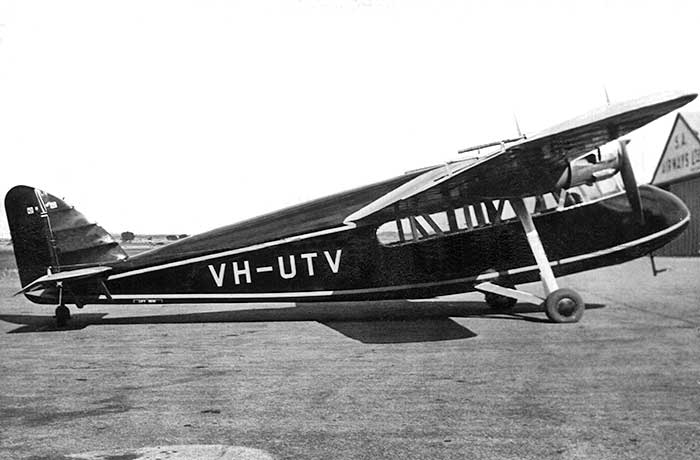
Photo supplied by Adelaide Airways to the Civil Aviation Board to be attached to VH-UTV's CofA form
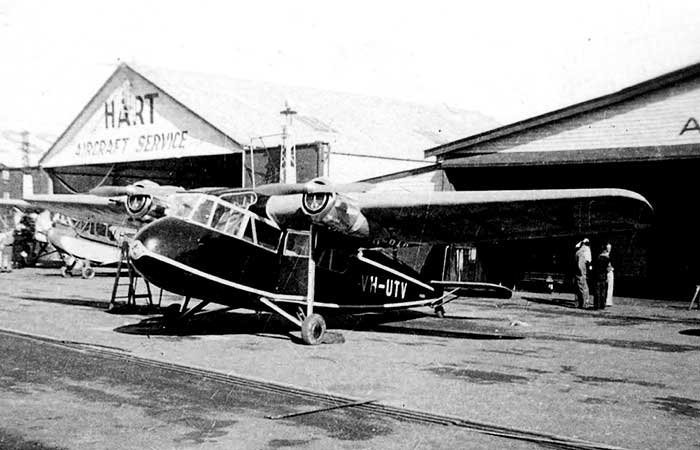
Photo: Civil Aviation Historical Society
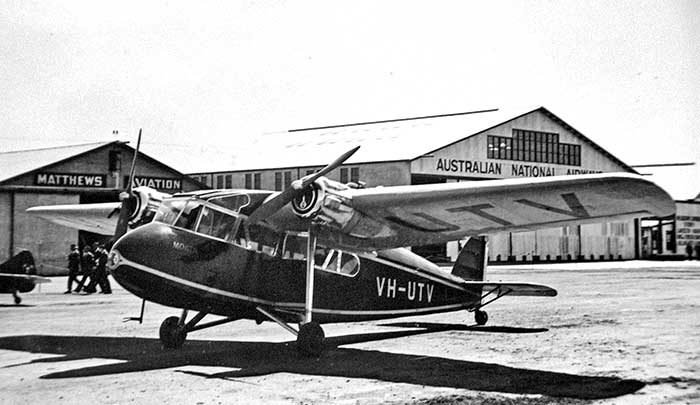
Photo: Civil Aviation Historical Society
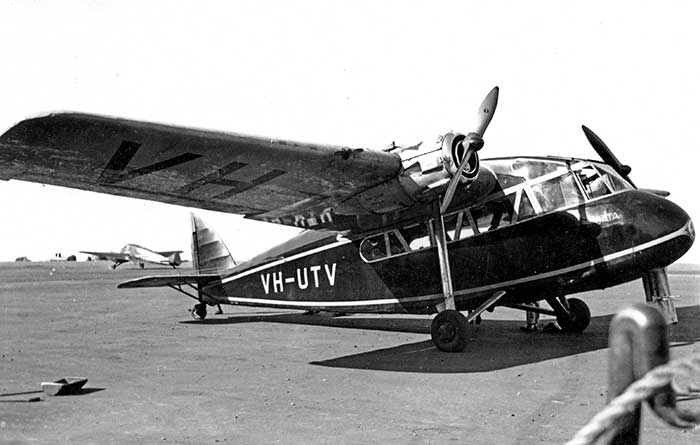
John Hopton Collection
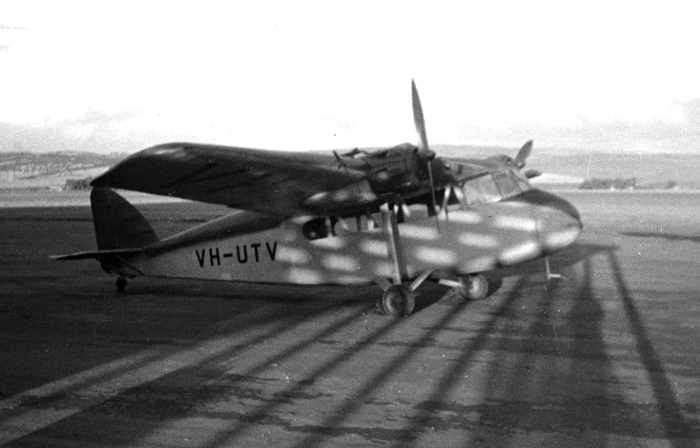
Parafield circa 1943 in a different paint scheme following ANA retirement. Photo: CAHS Allan Betteridge Collection
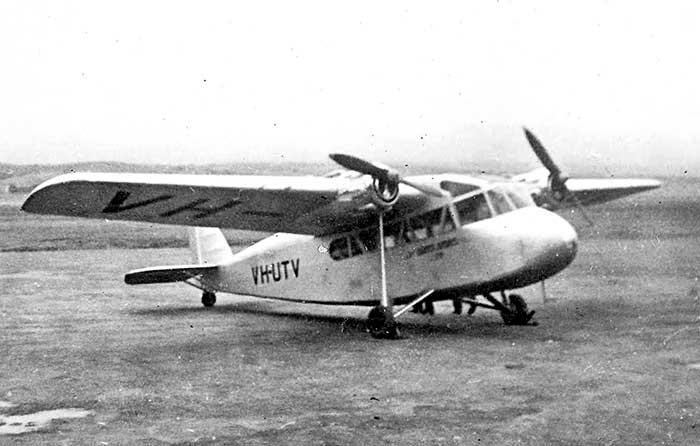
flew it on the short Whyalla-Port Pitie water crossing for the airline. Photo: CAHS Allan Betteridge Collection
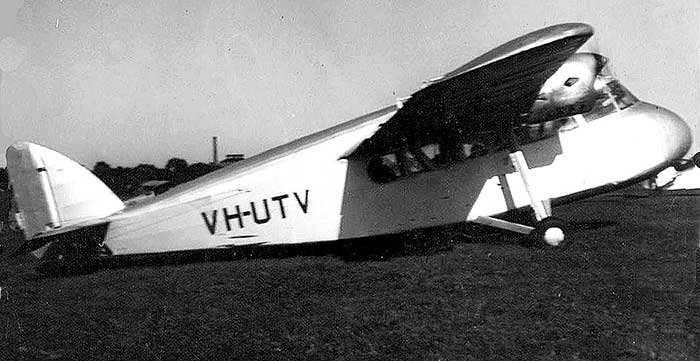
Photo by Bob Fripp

Photos: DCA Air Safety Investigation Branch
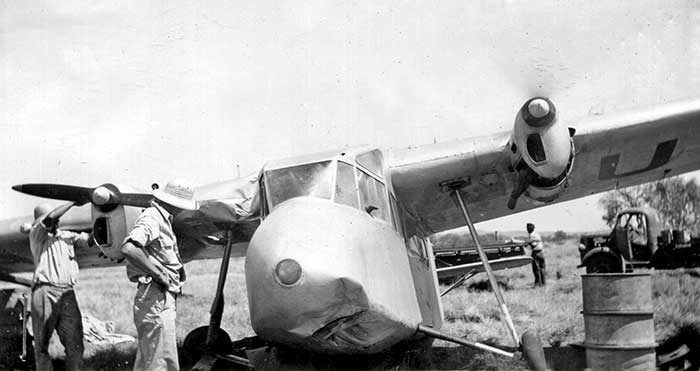


The Scion was not to fly again for six years.
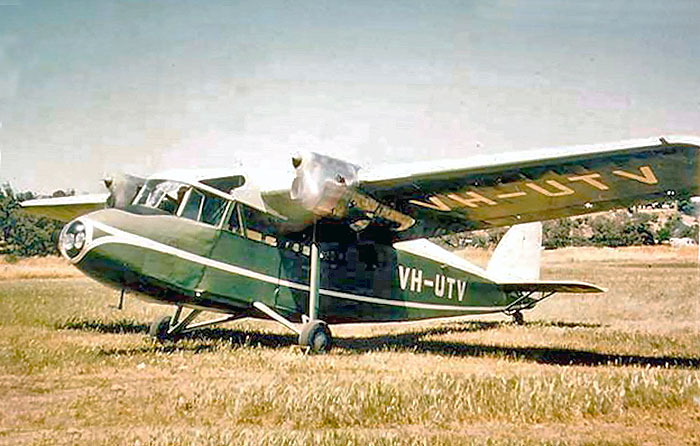

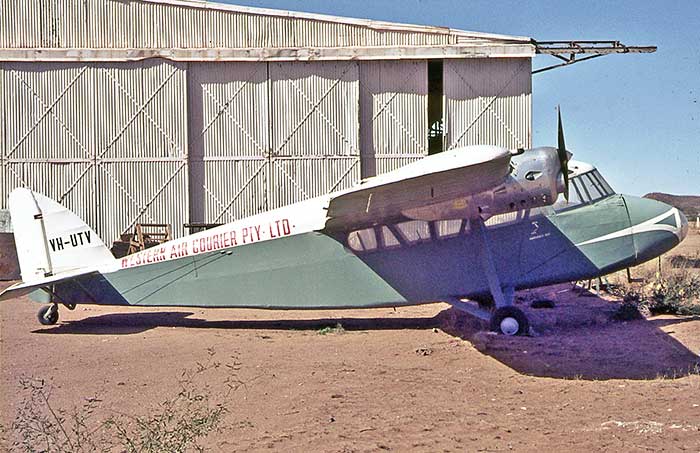
Details on Western Air Courier are not known, but they did not operate the Scion.
Photos above and below: John Hopton Collection

- Australian Civil Aircraft Register, Department of Civil Aviation and its successors
- National Archives of Australia, Melbourne:
DCA aircraft files
DCA file: VH-UTV accident Barrow Creek 3.12.46,
DCA file: VH-UTV re-engining with Gipsy Minors 1946
Military Service Files, Accession A9300 RAAF: Norman Gunn Padgett 1939-1948
Dept of External Affairs, Accession A1067, Flight of N.G.Padgett Scion to Borneo VH-UTV
- National Library of Australia: Trove newspapers search
- Historic Civil Aircraft Register of Australia G-AUAA to VH-UZZ, Bert Cookson, Austairdata, 1996
- British Civil Aircraft Since 1919, A. J. Jackson, Putnam London 1974
- The Historic Civil Aircraft Register G-AUAA to VH-UZZ: Bert Cookson, Austairdata 1996
- Flypast - A Record of Aviation in Australia, N. M. Parnell & T. W. Boughton, AGPS1988
- Wings of Gold, How the Aeroplane Developed New Guinea, James Sinclair, Pacific Publications 1978
- Harrison Air Log, John T. Harrison, diary of his flights for aerial photography
- The Short Scion, Vintage Aircraft magazine, April 1980
- Willis Reeve, a talk to an AHSA meeting 24 May 1978, Aviation Heritage Vol.43 No.1
- Gregory R. Banfield: unpublished biography of Sid Marshall
- David Vincent, Adelaide: research into Norman Padgett's Kingfisher A48-5
- David Vincent, Kangaroo Kingfishers, Air Enthusiast No.77 September 1998
- John P. Kellow: "Out of Control in the Centre", self-published memoirs, 2002
- Rare Scion Progresses, Classic Wings Downunder magazine, Vol.4 No.2 April-June 1997
- VH-UTV Airframe logbooks: held at Chewing Gum Field Air Museum in 1977: transcribed by Ben Dannecker
- Short Scion VH-UTV, Ben Dannecker, The Boxkiter newsletter, February 1978
- Melvyn R. Davis: interview with Mr. J.R. Robinson at Archerfield Qld 10 May 1973 re VH-UTV ownership
- Owen Lawry: letter January 2004 with recollections of 1958 ferry flight to Alice Springs
- Classic Wings Downunder magazine, renamed Classic Wings: NZ quarterly: Scion reports
- Australian Air Log: monthly journal 1965-1968: Scion reports
- AHSA Journal, Aviation Historical Society of Australia, monthly journal, 1960-1970: Scion reports